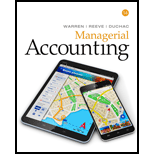
Concept explainers
(a)
Direct cost:
A cost indicates the payment of cash or the obligation to pay the cash in the future period for the generation of revenue or the service performed. A direct cost is the cost which is directly involved in the process of production. For example: The cost of plastic is the direct material for manufacturing a bottle.
Indirect cost:
An indirect cost is the cost which is indirectly involved in the process of production. For example: The salary of supervisor of a manufacturing business cannot be traced even though the supervisor contributes for the production.
Cost object:
A cost object is something to which costs are assigned, it is often a product lines or customers department for which costs are accumulated or measured by the management.
To explain: The most logical definition for the final cost object.
(b)
To classify: Each cost as either direct cost or indirect cost.
Want to see the full answer?
Check out a sample textbook solution
Chapter 1 Solutions
Managerial Accounting, Loose-leaf Version
- A company uses the average cost method for inventory valuation. The following transactions occurred during the month: Beginning Inventory: 100 units @ $20 each • Purchase 1: 200 units @ $25 each • Purchase 2: 300 units @ $30 each Units Sold: 400 units What is the Cost of Goods Sold (COGS) using the Average Cost Method? Options: A. $10,000 B. $10,400 C. $10,668 D. $10,800arrow_forwardans plz accounting questionarrow_forwardFinancial accountingarrow_forward
 Managerial AccountingAccountingISBN:9781337912020Author:Carl Warren, Ph.d. Cma William B. TaylerPublisher:South-Western College Pub
Managerial AccountingAccountingISBN:9781337912020Author:Carl Warren, Ph.d. Cma William B. TaylerPublisher:South-Western College Pub
